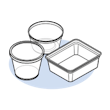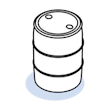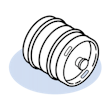Glossary
Package Types
Bag
A flexible package that can be made from rollstock film on a form/fill/seal machine (horizontal or vertical) or one that is pre-made and filled and sealed with product at the time of packaging. Also included here are paper and paper-laminated bags.

Chub Pack
Cylindrical flexible plastic tubes in the shape of a sausage that are filled and tied at both ends with a a metal or plastic tie.

Flow Wrap
A type of pack made on flowrapper machines, designed for individually wrapped products such as such as candy or granola bars.

Overwrap
A wide range of plastic and paper materials that serve to protect or envelop products. These materials can consist of clear films or unprinted papers, but they can also be printed. Overwrap films are considered to be distinct from shrink films.

Pouch
A flexible container that usually features thicker walls than a bag, or that often has a gusset or pocket on the bottom.

Sachet
Small pouches used for a variety of applications such as single-serve ketchup, mayonnaise, sugar, salt and pepper packets.

Stand-up Pouch
Special form of pouch with flat bottom seal that allows it to stand up vertically on store shelves.

Stick Pack
A type of flexible package resembling a tube with a single fin seal along the length of the package that contains a single serving of product, such as powders or yogurts.

Thermoformed Vacuum Pack
Any package that is made with thermoform/fill/seal equipment whereby a vacuum removes air in packaging so that it conforms to the shape of the product, such as a thermoformed vacuum pack of dates.

Vacuum Shrink Pack
A type of package using shrink film, formed on flow wrappers, chamber- and rotary-chamber machine style bag sealers, steam tunnels and shrink tunnels that wraps tightly around the product (i.e., a lamb shank) and during the vacuum sealing process.

Ampoule or Vial
Small glass or plastic containers, used mainly in medical and pharmaceutical packaging applications that often include measured doses.

Bag-in-box for Liquids
A plastic or multilayer bag that is housed in an outer corrugated box or metal wire container, often for bulk items, that allows for easier handling, shipment, and storage, such as a bag-in-box containing bulk tomato sauce shipped to food service operations.

Bottle or Jar
Any rigid plastic or glass container that is used to contain a variety of liquids or solids. Bottles can also be made from aluminum or even paperboard.

Can or Canister
Cans are cylindrical metal containers, typically made from aluminum or steel (but also plastic) that are used for a wide variety of liquid and solids. A canister typically refers to a spiral-wound, paper-based container with a paper or plastic lid or overcap, for a wide range of dry products. A typical example is a paperboard canister for dry oatmeal.

Carton (Folding)
Paperboard-based containers formed from flat sheets by a folding carton converter or manufacturer that are erected by the end user into a variety of shapes, styles and formats, such as a folding carton containing tea bags.

Carton (Gabletop)
Gabletop style paperboard cartons that feature a pyramid-shaped closed top. Gabletop cartons are most commonly associated with milk and juice applications.

Cartridge
Cartridges refer to any kind of specially manufactured container that contains raw product and fits into some sort of larger system, for example cartridges for injectable medicine applications.

Case
Rigid boxes, usually made of durable corrugated fiberboard, that are used for shipping, storing, transporting and sometimes displaying products.

Cup, Bowl or Tub
Rigid, concave packaging containers in a variety of formats, sizes and materials, characterized by a wide opening that’s typically the same as the diameter or width of the package itself. Examples include tubs for margarine, microwavable plastic bowls for frozen meals, and Styrofoam cups for ramen.

Syringe
In healthcare packaging, syringes are cylindrical devices made of glass or plastic with a hollow needle attached, used for drawing and administering fluids or medications.

Tray
Trays are shallow, rigid or semi-rigid containers made from a variety of materials that support and contain food as well as non-food products. Examples include microwavable polypropylene trays for frozen dinners, clear trays for rows of cookies or crackers. Baskets (sometimes known as punnets) refer to open or mesh containers, typically plastic, that are designed for holding fresh fruit or vegetables. Note: this category is distinct from corrugated shipping trays (see Paperboard & Corrugated).

Blister for Tablets
Semi-rigid, packages thermoformed, filled and sealed inline for pharmaceutical and nutraceutical applications that frequently hold pills or capsules and feature a rigid but flexible backing seal.

Blister Pack (Retail)
Slightly bendable, thermoformed packaging that displays packaging contents in a clear, rigid packaging, sometimes backed with paperboard backing, such as a blister pack of batteries.

Brick Pack (Laminate)
A rigid package that is made out of a thick paper/foil/film lamination formed, filled and sealed into the shape of a rigid container such as a brick or a variety of other shapes, such as for soy milks.

Clamshell
Semi-rigid, thermoformed packs that when folded together snap and lock the product during sealing, such as a clamshell containing donuts sold in grocery stories.

Portion Pack Cup
Thermoformed cups or bowls designed for single serving applications, such as a portion pack cup of chocolate pudding with a flexible peel-away lid.

Sleeve
A strip that wraps around a product or its outer package.

Thermoformed Semi-rigid Pack
Flat flexible trays formed on horizontal form/fill/seal equipment such as a thermoformed semi-rigid pack of salami.

Tube (Flexible)
Any flexible, cylindrical tube, made of plastic or metal, that can be squeezed by the consumer or end user to force product out, such as tubes for toothpaste or hair gel, or pharmaceutical ointments. These tubes come from the manufacturer with a threaded opening on one end and are open at the other. After product is filled into the tube, the open end is sealed.

Vacuum Skin Pack
Packages produced on vacuum packaging machines that conform tightly to the contour of the product and remove oxygen from the pack, such as a vacuum-pack of steak.

Drum
Cylindrical metal, plastic or composite paperboard containers for storage of bulk liquids, powders and related industrial materials or ingredients, typically 55 gallons.

Heavy Duty Industrial Sack
Large sacks of heavy-duty flexible fabric used to store dry products.

IBCs/Tote
One-way and reusable rigid industrial tanks that are mounted on pallets that are used to handle, transport and store materials and ingredients in processing and packaging operations from liquids to solids.

Keg or Cask
Cylindrical bulk containers made of various sizes wood, metal, and other materials that used to store and transport such as wine and olive oil.

Large Bag
Sacks and bags for a variety of applications and in a variety of formats, generally 50 lb and above. Examples might be a large bag of pet food or fertilizer. Valve bags are generally large, heavy duty paper bags used to contain building materials such as cement.

Lined Case
Any large or oversized case or pallet-sized box into which a plastic liner is slipped prior to filling with dry, bulk product for shipping or storage.

Pail
Plastic or metal containers that often have a flip-up metal carrying handle that are used for applications such as paint or foodservice applications.

Filter Terms
Coding, Labeling, Printing & Reading Equipment
Cold glue
Adhesive that requires no heat to melt and apply to a package.
Hot melt glue
Melted adhesive that is applied during forming and sealing of cartons and case flaps.
Water activated
Type of adhesive that needs water or liquid to activate adhesive properties.
Coding, Labeling, Printing & Reading Equipment
Case coding
Printing or marking of information such as serial numbers, bar codes and company brand information directly onto the surface of a shipping case.
Package coding
Coding placed on packages as opposed to being placed on the product itself or on a case.
Pallet coding
Marking system to identify a pallet.
Product coding
Marking and coding systems that are placed directly onto the surface of a product.
Conveying, Feeding & Handling
Cases
Equipment can handle shipping cases.
Packages
Any box, bottle, carton, bag, tube or related item used to contain a product.
Raw product
Refers to product in its most basic and unprocessed form, such as milk, meat, or oranges.
Palletizing & Load Stabilization
Bags
Flexible paper or plastic containers filled with dry or wet product.
Bulk containers
Machinery that can handle bulk/industrial packaging applications such as filling drums, IBCs, and FIBCs.
Cases
Equipment can handle shipping cases.
Containers
Rigid packages made of plastic, paper or other materials.
Bagging, Pouching & Wrapping Equipment
Portion pack
Package that includes a single unit, dose, or serving.
Quad-seal bags
Bag or pouch that is sealed at four points.
Stand-up pouch
Also known as doypacks, stand-up pouches are flexible packages that have gussets allowing them to stand vertically erect on a store shelf.
Stick pack
A type of flexible package resembling a tube with a single fin seal along the length of the package that contains a single serving of product, such as powders or yogurts.
Tri-seal bags
A bag or pouch sealed in three places.
Conveying, Feeding & Handling
Chain
Type of conveyor format that uses metal linked chains.
Mesh
Type of conveying belt with small holes, often used for drying or cooling products on processing lines.
Non-stick
Packaging feature that keeps product from sticking to the packaging substrate.
Polymer
Belting type that is made of synthetic plastic.
Steel
Metal used for machine parts, designed for durability and rust prevention.
Synthetic fabric
Plastic and composite based material used for conveyor belts.
Bagging, Pouching & Wrapping Equipment
Entry-level/budget models available
Company offers economic models for start-ups and lower volume runs.
IIoT ready
Refers to a machine's ability to connect to the industrial internet of things (IIoT) in which machines and devices on a plant floor share the same network as a company’s facility management applications.
PackML controls architecture
Set of technical standards for industrial automation controls on packaging machines.
Tool-less changeover
No special tools are required to make adjustments between production runs.
Cartoning, Multipacking & Case Packing
Entry-level/budget models available
Company offers economic models for start-ups and lower volume runs.
IIoT ready
Refers to a machine's ability to connect to the industrial internet of things (IIoT) in which machines and devices on a plant floor share the same network as a company’s facility management applications.
PackML controls architecture
Set of technical standards for industrial automation controls on packaging machines.
Tool-less changeover
No special tools are required to make adjustments between production runs.
Coding, Labeling, Printing & Reading Equipment
Entry-level/budget models available
Company offers economic models for start-ups and lower volume runs.
IIoT ready
Refers to a machine's ability to connect to the industrial internet of things (IIoT) in which machines and devices on a plant floor share the same network as a company’s facility management applications.
PackML controls architecture
Set of technical standards for industrial automation controls on packaging machines.
Tool-less changeover
No special tools are required to make adjustments between production runs.
Conveying, Feeding & Handling
Entry-level/budget models available
Company offers economic models for start-ups and lower volume runs.
IIoT ready
Refers to a machine's ability to connect to the industrial internet of things (IIoT) in which machines and devices on a plant floor share the same network as a company’s facility management applications.
PackML controls architecture
Set of technical standards for industrial automation controls on packaging machines.
Tool-less changeover
No special tools are required to make adjustments between production runs.
Filling, Capping & Closing
Entry-level/budget models available
Company offers economic models for start-ups and lower volume runs.
IIoT ready
Refers to a machine's ability to connect to the industrial internet of things (IIoT) in which machines and devices on a plant floor share the same network as a company’s facility management applications.
PackML controls architecture
Set of technical standards for industrial automation controls on packaging machines.
Tool-less changeover
No special tools are required to make adjustments between production runs.
Inspection & Testing Equipment
Entry-level/budget models available
Company offers economic models for start-ups and lower volume runs.
Palletizing & Load Stabilization
Entry-level/budget models available
Company offers economic models for start-ups and lower volume runs.
IIoT ready
Refers to a machine's ability to connect to the industrial internet of things (IIoT) in which machines and devices on a plant floor share the same network as a company’s facility management applications.
PackML controls architecture
Set of technical standards for industrial automation controls on packaging machines.
Tool-less changeover
No special tools are required to make adjustments between production runs.
Processing Equipment
Entry-level/budget models available
Company offers economic models for start-ups and lower volume runs.
IIoT ready
Refers to a machine's ability to connect to the industrial internet of things (IIoT) in which machines and devices on a plant floor share the same network as a company’s facility management applications.
PackML controls architecture
Set of technical standards for industrial automation controls on packaging machines.
Tool-less changeover
No special tools are required to make adjustments between production runs.
Robot Manufacturers & Integrators
Entry-level/budget models available
Company offers economic models for start-ups and lower volume runs.
IIoT ready
Refers to a machine's ability to connect to the industrial internet of things (IIoT) in which machines and devices on a plant floor share the same network as a company’s facility management applications.
PackML controls architecture
Set of technical standards for industrial automation controls on packaging machines.
Tool-less changeover
No special tools are required to make adjustments between production runs.
Specialty Equipment
Entry-level/budget models available
Company offers economic models for start-ups and lower volume runs.
IIoT ready
Refers to a machine's ability to connect to the industrial internet of things (IIoT) in which machines and devices on a plant floor share the same network as a company’s facility management applications.
PackML controls architecture
Set of technical standards for industrial automation controls on packaging machines.
Tool-less changeover
No special tools are required to make adjustments between production runs.
Tray, Clamshell & Blister Packaging Equipment
Entry-level/budget models available
Company offers economic models for start-ups and lower volume runs.
IIoT ready
Refers to a machine's ability to connect to the industrial internet of things (IIoT) in which machines and devices on a plant floor share the same network as a company’s facility management applications.
PackML controls architecture
Set of technical standards for industrial automation controls on packaging machines.
Tool-less changeover
No special tools are required to make adjustments between production runs.
Cartoning, Multipacking & Case Packing
Bliss
Shipping boxes typically consisting of two end panels and a fold-up panel that forms the sides.
Case liners
Lightweight paper or plastic film inserted into the body of a case prior to being loaded with product that forms a barrier between the product and the case.
Corrugated tray
Heavy-duty paper based cases where the top of the case is removed and wrapped, such as a shipping tray for 30 cans of soup.
RSC-pre glued
Regular slotted container (RSC) boxes that come with pre-applied adhesives that are activated and sealed on a case packing line.
Wraparound
Case or tray feature whereby corrugated panels are wrapped around a corrugated base.
Bagging, Pouching & Wrapping Equipment
Dairy 3A
Criteria for equipment standards and processing best practices for hygienic processing within the food, beverage and pharmaceutical industries maintained by the 3-A Sanitary Standards organization.
Hygienic (low-moisture)
Processing standards and guidelines that minimize the entry of pathogens such as salmonella in low-moisture foods (foods with water activity of 0.85 or below.)
Washdown (wet)
Cleaning and sanitation of the surface of machine, usually following a production run.
Cartoning, Multipacking & Case Packing
Dairy 3A
Criteria for equipment standards and processing best practices for hygienic processing within the food, beverage and pharmaceutical industries maintained by the 3-A Sanitary Standards organization.
Hygienic (low-moisture)
Processing standards and guidelines that minimize the entry of pathogens such as salmonella in low-moisture foods (foods with water activity of 0.85 or below.)
Washdown (wet)
Cleaning and sanitation of the surface of machine, usually following a production run.
Controls, Software & Components
Hygienic (low-moisture)
Processing standards and guidelines that minimize the entry of pathogens such as salmonella in low-moisture foods (foods with water activity of 0.85 or below.)
Washdown (wet)
Cleaning and sanitation of the surface of machine, usually following a production run.
Conveying, Feeding & Handling
Hygienic (low-moisture)
Processing standards and guidelines that minimize the entry of pathogens such as salmonella in low-moisture foods (foods with water activity of 0.85 or below.)
Washdown (wet)
Cleaning and sanitation of the surface of machine, usually following a production run.
Filling, Capping & Closing
CIP
Clean-In-Place systems that automatically clean and sanitize the inside of processing machinery.
Dairy 3A
Criteria for equipment standards and processing best practices for hygienic processing within the food, beverage and pharmaceutical industries maintained by the 3-A Sanitary Standards organization.
Hygienic (low-moisture)
Processing standards and guidelines that minimize the entry of pathogens such as salmonella in low-moisture foods (foods with water activity of 0.85 or below.)
Washdown (wet)
Cleaning and sanitation of the surface of machine, usually following a production run.
Plant & Warehouse Infrastructure and Operations
CIP
Clean-In-Place systems that automatically clean and sanitize the inside of processing machinery.
Dairy 3A
Criteria for equipment standards and processing best practices for hygienic processing within the food, beverage and pharmaceutical industries maintained by the 3-A Sanitary Standards organization.
Food-grade
Suitable for contact with food, per regulation.
HEPA
Standard for air quality within a plant based on the use of high-efficiency particulate absorbing filter technology that removes at least 99.9% of particles such as pollen, dirt, and dust.
Hygienic (low-moisture)
Processing standards and guidelines that minimize the entry of pathogens such as salmonella in low-moisture foods (foods with water activity of 0.85 or below.)
Washdown (wet)
Cleaning and sanitation of the surface of machine, usually following a production run.
Processing Equipment
CIP
Clean-In-Place systems that automatically clean and sanitize the inside of processing machinery.
Dairy 3A
Criteria for equipment standards and processing best practices for hygienic processing within the food, beverage and pharmaceutical industries maintained by the 3-A Sanitary Standards organization.
Hygienic (low-moisture)
Processing standards and guidelines that minimize the entry of pathogens such as salmonella in low-moisture foods (foods with water activity of 0.85 or below.)
Washdown (wet)
Cleaning and sanitation of the surface of machine, usually following a production run.
Robot Manufacturers & Integrators
Hygienic (low-moisture)
Processing standards and guidelines that minimize the entry of pathogens such as salmonella in low-moisture foods (foods with water activity of 0.85 or below.)
Washdown (wet)
Cleaning and sanitation of the surface of machine, usually following a production run.
Tray, Clamshell & Blister Packaging Equipment
CIP
Clean-In-Place systems that automatically clean and sanitize the inside of processing machinery.
Dairy 3A
Criteria for equipment standards and processing best practices for hygienic processing within the food, beverage and pharmaceutical industries maintained by the 3-A Sanitary Standards organization.
Hygienic (low-moisture)
Processing standards and guidelines that minimize the entry of pathogens such as salmonella in low-moisture foods (foods with water activity of 0.85 or below.)
Washdown (wet)
Cleaning and sanitation of the surface of machine, usually following a production run.
Palletizing & Load Stabilization
Layer forming
Pick and Place
Row forming
Controls, Software & Components
Explosion-proof
Filling, sealing and other packaging systems that safely handle hazardous and combustible products.
Filling, Capping & Closing
Explosion-proof
Filling, sealing and other packaging systems that safely handle hazardous and combustible products.
Frozen
Packaging and processing systems that can maintain operating temperatures below 30 deg F at all times.
Material Handling & Warehousing
Explosion-proof
Filling, sealing and other packaging systems that safely handle hazardous and combustible products.
Frozen
Packaging and processing systems that can maintain operating temperatures below 30 deg F at all times.
Refrigerated
Refers to packaging environments and the machines and materials, where operations are below 30 deg F.
Plant & Warehouse Infrastructure and Operations
Corrosive
Environment prone to corrosion of equipment, such as high-temperature or high-humidity ambients.
Dry
Plant facility or operation with low humidity and low water usage.
Explosion-proof
Filling, sealing and other packaging systems that safely handle hazardous and combustible products.
Frozen
Packaging and processing systems that can maintain operating temperatures below 30 deg F at all times.
High-temperature
Capable of withstanding processing or packaging ambients above room temperature.
Humidity control
Features that control the impact of humidity in a machine or environment.
Refrigerated
Refers to packaging environments and the machines and materials, where operations are below 30 deg F.
Wet
Any processing technique that involves the introduction of water or other liquid ingredients.
Processing Equipment
Wet
Any processing technique that involves the introduction of water or other liquid ingredients.
Robot Manufacturers & Integrators
Frozen
Packaging and processing systems that can maintain operating temperatures below 30 deg F at all times.
Refrigerated
Refers to packaging environments and the machines and materials, where operations are below 30 deg F.
Bagging, Pouching & Wrapping Equipment
Aseptic
Process technique that creates shelf-stable products using thermal sterilization that remove microorganisms from both the container and the product
Controlled atmosphere packaging
Controlled atmosphere packaging (CAP) or controlled atmosphere storage (CAS) is a technique where the gases within a package can be controlled using films and coatings as well as heat and humidity during packaging to extend a product's shelf life.
Modified atmosphere packaging
Modified atmosphere packaging or MAP displaces normal air within a package with a low-oxygen atmosphere that extends shelf life and eliminates the use of chemicals for preservation.
UHT
Ultra-high temperature processing refers to processes whereby food is sterilized by heating it to temperatures that exceed 135 °C from 2 to 5 seconds.
Ultraclean
One step short of aseptic.
Vacuum packaging
Any packaging technology that uses vacuum systems to remove air from a package prior to sealing.
Filling, Capping & Closing
Aseptic
Process technique that creates shelf-stable products using thermal sterilization that remove microorganisms from both the container and the product
Controlled atmosphere packaging
Controlled atmosphere packaging (CAP) or controlled atmosphere storage (CAS) is a technique where the gases within a package can be controlled using films and coatings as well as heat and humidity during packaging to extend a product's shelf life.
Dosing (propellant or liquid gas)
Machinery handles dosing applications involving pressurized or liquid gas.
Modified atmosphere packaging
Modified atmosphere packaging or MAP displaces normal air within a package with a low-oxygen atmosphere that extends shelf life and eliminates the use of chemicals for preservation.
UHT
Ultra-high temperature processing refers to processes whereby food is sterilized by heating it to temperatures that exceed 135 °C from 2 to 5 seconds.
Ultraclean
One step short of aseptic.
Processing Equipment
Aseptic
Process technique that creates shelf-stable products using thermal sterilization that remove microorganisms from both the container and the product
UHT
Ultra-high temperature processing refers to processes whereby food is sterilized by heating it to temperatures that exceed 135 °C from 2 to 5 seconds.
Ultraclean
One step short of aseptic.
Tray, Clamshell & Blister Packaging Equipment
Aseptic
Process technique that creates shelf-stable products using thermal sterilization that remove microorganisms from both the container and the product
Controlled atmosphere packaging
Controlled atmosphere packaging (CAP) or controlled atmosphere storage (CAS) is a technique where the gases within a package can be controlled using films and coatings as well as heat and humidity during packaging to extend a product's shelf life.
Dosing (propellant or liquid gas)
Machinery handles dosing applications involving pressurized or liquid gas.
Modified atmosphere packaging
Modified atmosphere packaging or MAP displaces normal air within a package with a low-oxygen atmosphere that extends shelf life and eliminates the use of chemicals for preservation.
UHT
Ultra-high temperature processing refers to processes whereby food is sterilized by heating it to temperatures that exceed 135 °C from 2 to 5 seconds.
Ultraclean
One step short of aseptic.
Vacuum packaging
Any packaging technology that uses vacuum systems to remove air from a package prior to sealing.
Conveying, Feeding & Handling
Buffering
Feature on package handling systems that organizes, orients or reposition packages to allow for maximum throughput efficiency without stoppages.
Collating
Package and product handling feature on a machine that collects or combines items on a line.
Counting
Machine feature that counts the number of units of a product as they are fed into the machine.
Indexing
Conveyor feature that allows the machine to transport products in a series of steps rather than a continuous flow.
Inverting
Handling systems designed to invert containers.
Jam control
Built-in feature to eliminate jamming on a conveying or accumulation line.
Sorting
Machine feature that stacks or otherwise organizes packaging components (such as bottle caps) to prepare them for a feeding and inserting operation.
Conveying, Feeding & Handling
Loose
Refers to the order of how a product arrives to a packaging or filling station on a line.
Rolls
Refers to narrow web material wound onto a core.
Stacks
Feature that allows machines to handle vertical stacks of products or packages.
Bagging, Pouching & Wrapping Equipment
Hot fill
Systems that use heat at 194 deg F or above to sterilize the product and inside of a container to increase shelf life.
Filling, Capping & Closing
Compensator filling
Feature on a filling machine that monitors flow of product and adjusts speeds accordingly.
Fill by time
Machines that fill or deposit products by the time under a filling head.
Fill by weight
Machines that fill or deposit products by calculating the weight of the package after filling.
Hot fill
Systems that use heat at 194 deg F or above to sterilize the product and inside of a container to increase shelf life.
Positive displacement
Filling systems with an operational cycle that traps a specific volume of product within a chamber using suction technology before discharging it into a container.
Volumetric
Machines that fill or deposit products by volume.
Materials, Containers & Consumables
Blown films
Films manufactured by blowing molten resin through a extruder to create flat film that is wound onto a roller.
Cast films
Film manufactured via extruding molten polymer through a die that is later cooled on a chill roll.
Coextruded
Refers to multiple layers/walls of packaging during the package formation process.
Bagging, Pouching & Wrapping Equipment
Radiant heat
Heat tunnel technology used in shrinking tamper-evident bands, wrap and shrink sleeves via infrared waves.
Steam
Vaporous water.
Bagging, Pouching & Wrapping Equipment
Automatic
Operations in which all of the major work cycles of a machine are completed without the requirement of human intervention.
Manual
Production operations, usually low-volume, that require a human to manually initiate and conclude the work process of a machine.
Pilot/lab
Low-volume production during product development and prototyping such that no automation process is involved.
Semi-automatic
Machines that feature some automated operations but require a human operator to do others, such as manual feeding or product removal.
Cartoning, Multipacking & Case Packing
Automatic
Operations in which all of the major work cycles of a machine are completed without the requirement of human intervention.
Manual
Production operations, usually low-volume, that require a human to manually initiate and conclude the work process of a machine.
Pilot/lab
Low-volume production during product development and prototyping such that no automation process is involved.
Semi-automatic
Machines that feature some automated operations but require a human operator to do others, such as manual feeding or product removal.
Filling, Capping & Closing
Automatic
Operations in which all of the major work cycles of a machine are completed without the requirement of human intervention.
Manual
Production operations, usually low-volume, that require a human to manually initiate and conclude the work process of a machine.
Pilot/lab
Low-volume production during product development and prototyping such that no automation process is involved.
Semi-automatic
Machines that feature some automated operations but require a human operator to do others, such as manual feeding or product removal.
Inspection & Testing Equipment
Automatic
Operations in which all of the major work cycles of a machine are completed without the requirement of human intervention.
Manual
Production operations, usually low-volume, that require a human to manually initiate and conclude the work process of a machine.
Pilot/lab
Low-volume production during product development and prototyping such that no automation process is involved.
Semi-automatic
Machines that feature some automated operations but require a human operator to do others, such as manual feeding or product removal.
Material Handling & Warehousing
Automatic
Operations in which all of the major work cycles of a machine are completed without the requirement of human intervention.
Manual
Production operations, usually low-volume, that require a human to manually initiate and conclude the work process of a machine.
Semi-automatic
Machines that feature some automated operations but require a human operator to do others, such as manual feeding or product removal.
Palletizing & Load Stabilization
Automatic
Operations in which all of the major work cycles of a machine are completed without the requirement of human intervention.
Manual
Production operations, usually low-volume, that require a human to manually initiate and conclude the work process of a machine.
Semi-automatic
Machines that feature some automated operations but require a human operator to do others, such as manual feeding or product removal.
Processing Equipment
Automatic
Operations in which all of the major work cycles of a machine are completed without the requirement of human intervention.
Manual
Production operations, usually low-volume, that require a human to manually initiate and conclude the work process of a machine.
Pilot/lab
Low-volume production during product development and prototyping such that no automation process is involved.
Semi-automatic
Machines that feature some automated operations but require a human operator to do others, such as manual feeding or product removal.
Skid-mounted
Processing equipment that is modular and mounted on a skid for mobility, such as CIP systems, bio processors, blowers and dryers.
Specialty Equipment
Automatic
Operations in which all of the major work cycles of a machine are completed without the requirement of human intervention.
Manual
Production operations, usually low-volume, that require a human to manually initiate and conclude the work process of a machine.
Pilot/lab
Low-volume production during product development and prototyping such that no automation process is involved.
Semi-automatic
Machines that feature some automated operations but require a human operator to do others, such as manual feeding or product removal.
Tray, Clamshell & Blister Packaging Equipment
Automatic
Operations in which all of the major work cycles of a machine are completed without the requirement of human intervention.
Manual
Production operations, usually low-volume, that require a human to manually initiate and conclude the work process of a machine.
Pilot/lab
Low-volume production during product development and prototyping such that no automation process is involved.
Semi-automatic
Machines that feature some automated operations but require a human operator to do others, such as manual feeding or product removal.
Palletizing & Load Stabilization
Floor-level
Palletizing machine configuration where loads are formed on the floor, as opposed to in tall stacks.
High-level
Palletizing system that handles stacks of pallets.
Cartoning, Multipacking & Case Packing
Auto load
Machine feature that automatically loads product for placement into the container or package.
Bottom load
Case packing configuration in which product to be cased is first loaded onto a corrugated flat, later to be enveloped by the top and side case flats.
Horizontal/End/Side Load
Case packing configuration in which product to be cased is first loaded with an open case on its side, later to be enveloped by folding the bottom and top case flaps.
Manual load
Product or package loading that is performed manually, in contrast to being an automated operation.
Robotic loading
Placement of ingredients or products into a package or container via robotic means.
Vertical/Top/drop load
Case packing method whereby items to be placed in the case are dropped vertically, using gravity.
Filling, Capping & Closing
Gas flush
System of eliminating oxygen from the inside of package by injecting insert gases.
Steam flush
Cleaning and sanitizing method using vaporous water.
Vacuum sealing
Systems that remove air from the inside of a package prior to sealing.
Bagging, Pouching & Wrapping Equipment
Box motion
Refers to flow wrapping feature that wraps items in a box-like pattern.
Continuous motion
Machine feature that allows it to handle products continuously without stopping.
Dual lane
Conveying or feeding machine attribute whereby products are fed in two separate lanes simultaneously.
Inline
Packaging systems that fill or load containers coming in a straight line.
Intermittent motion
Machine feature that starts and stops motion to hold products or packages in place for specific line functions, as opposed to continuous motion.
Large Format
Oversized, long or large products such as plywood boards, doors, and related products.
Multi-lane
Conveying feature whereby products are conveying on multiple lanes as opposed to a single lane.
Rotary
Packaging systems used in filling, depositing and capping that rotate containers to be filled in a circular manner, using a centering device such as a star wheel to place the container in place before filling and being returned to the conveyor.
Cartoning, Multipacking & Case Packing
Robotic
Of or related to robots and automated equipment.
Coding, Labeling, Printing & Reading Equipment
3D/QR codes
Machines that are capable of printing 3D and QR codes.
Bar codes
Machine readable data printed onto a package.
Inline
Packaging systems that fill or load containers coming in a straight line.
Large character
Marking and coding feature that produces large numbers and letters for easy legibility.
Linerless
Label type that uses a special coating that eliminates the usual liner material to which traditional labels are adhered.
Rotary
Packaging systems used in filling, depositing and capping that rotate containers to be filled in a circular manner, using a centering device such as a star wheel to place the container in place before filling and being returned to the conveyor.
Small character
Marking and coding feature allowing the printing of numerals and letters in small fonts.
Weigh Price
Machines that apply price and weight labels, often to food products.
Converting & Package Forming Equipment
Narrow web
Converting machines that handle narrow webs such as those used in making bags and labels.
Conveying, Feeding & Handling
Incline/decline
Conveying systems that lift or lower packages or products from one station to another.
Reciprocating
Refers to machines that use mechanisms featuring a back-and-forth or up-and-down motion, rather than rotary or linear motion.
Robotic
Of or related to robots and automated equipment.
Rotary
Packaging systems used in filling, depositing and capping that rotate containers to be filled in a circular manner, using a centering device such as a star wheel to place the container in place before filling and being returned to the conveyor.
Vibratory
Type of feeding, conveying or handling whereby the product is shaken to release it from a hopper or conveyor into a package.
Filling, Capping & Closing
Inline
Packaging systems that fill or load containers coming in a straight line.
Monoblock
Packaging machines that combine more than one major packaging operation within a single unit, such as monobloc machines that blow mold containers before filling, and capping them.
Rigid container form/fill/seal
Forming, filling and sealing systems that fabricate rigid containers (as opposed to flexible packaging).
Rotary
Packaging systems used in filling, depositing and capping that rotate containers to be filled in a circular manner, using a centering device such as a star wheel to place the container in place before filling and being returned to the conveyor.
Inspection & Testing Equipment
Offline
A packaging process or step that is done independently of the main forming, filling and closing line of a packaging operation, such as barcoding of cartons as a separate operation.
Online
A packaging process or step that is done during the main forming, filling and closing of a container or package.
Material Handling & Warehousing
Robotic
Of or related to robots and automated equipment.
Palletizing & Load Stabilization
Liftoff
Lift-off lids are not sealed with glue and can be easily removed from boxes and cartons by the consumer.
Robotic
Of or related to robots and automated equipment.
Sweep-off
Palletizing method that removes rows to be palletizing one at a time.
Robot Manufacturers & Integrators
Gentle handling
Machine feature that permits handling of delicate or fragile products or packages without damaging them.
Tray, Clamshell & Blister Packaging Equipment
Cold forming
Blister pack production method that bonds foil and film without the use of heat.
Inline
Packaging systems that fill or load containers coming in a straight line.
Multi-lane
Conveying feature whereby products are conveying on multiple lanes as opposed to a single lane.
Robotic
Of or related to robots and automated equipment.
Rotary
Packaging systems used in filling, depositing and capping that rotate containers to be filled in a circular manner, using a centering device such as a star wheel to place the container in place before filling and being returned to the conveyor.
Materials, Containers & Consumables
Barrier
Quality of packaging material that preserves product integrity.
Gas-permeable
Material characteristic of plastic packaging that allows certain gases such as oxygen to permeate at a specified rate.
High-pressure processing
Related to systems that use enclosed chambers to apply pressure in place of heat to filled and sealed food or beverage containers as a method to inactivate harmful pathogens in products while retaining nutrients and taste profile and increasing shelf life.
In-mold labeled
Labels that are placed into the inset mold of a plastic container.
Metallized
Packaging material such as paper or film that has been coating with a thin layer or aluminum or another metal.
Retortable/retort
Refers to packaging materials and machinery processes that handle high-temperature retort processes.
Thermoformable
Material or container designed for thermoforming equipment.
Bagging, Pouching & Wrapping Equipment
Foil
Aluminum or metallic material used in wrapping applications.
Paper
Equipment handles paper-based substrates and material.
Plastic
Petroleum-based material that forms the basis of flexible and rigid plastic packaging.
Cartoning, Multipacking & Case Packing
Corrugated
Heavy-duty paper based products uses for cases.
Paperboard
Paper-fiber based packaging materials used for cartons, boxes, cases and related supplies.
Converting & Package Forming Equipment
Composite
Materials formed out of a combination of plastic, paper and other substrates.
Corrugated
Heavy-duty paper based products uses for cases.
Glass
Equipment that creates or handles glass packaging, such as bottles and vials.
Metal
Any type of metallic, aluminum or foil material.
Paper
Equipment handles paper-based substrates and material.
Plastic
Petroleum-based material that forms the basis of flexible and rigid plastic packaging.
Conveying, Feeding & Handling
Fabric
Type of conveyor belting made of synthetic fabric.
Vertical
Orientation of packaging equipment that drops product into packages vertically.
Materials, Containers & Consumables
Composite
Materials formed out of a combination of plastic, paper and other substrates.
Corrugated
Heavy-duty paper based products uses for cases.
Fabric
Type of conveyor belting made of synthetic fabric.
Foamed
Any type of foamed plastic (usually made of polystyrene) material.
Glass
Equipment that creates or handles glass packaging, such as bottles and vials.
Metal
Any type of metallic, aluminum or foil material.
Paper
Equipment handles paper-based substrates and material.
Plastic
Petroleum-based material that forms the basis of flexible and rigid plastic packaging.
Cartoning, Multipacking & Case Packing
E-commerce
Packaging features and materials related to shipping products sold online.
Specialty/Decorative Carton
A primary product container for non-fluid products that comes in a variety of formats (gable top, squared off. or other special shape),designed mainly to attract attention at retail.
Tamper-evident
Safety feature on packaging closures that allows consumer to detect if the packaging has been previously opened or tampered with.
Coding, Labeling, Printing & Reading Equipment
Tamper-evident
Safety feature on packaging closures that allows consumer to detect if the packaging has been previously opened or tampered with.
Filling, Capping & Closing
Tamper-evident
Safety feature on packaging closures that allows consumer to detect if the packaging has been previously opened or tampered with.
Materials, Containers & Consumables
Anti-counterfeit
Security features on a package that help to minimize counterfeiting, such as holograms, 2-D barcodes, and radio frequency identification systems.
Child resistance/senior friendly
Package feature that either makes it difficult for a child to open or easier for a senior citizen to open.
Custom shape
Containers designed in unique patterns or shapes.
E-commerce
Packaging features and materials related to shipping products sold online.
Tamper-evident
Safety feature on packaging closures that allows consumer to detect if the packaging has been previously opened or tampered with.
Materials, Containers & Consumables
Box
Any rectangular or square package, usually paperboard or corrugated, consisting of six sides.
Carton
Packaging material, most often made of lightweight paperboard, that is folded in various styles and formats to form folding cartons, boxes, and other packages.
Divider
Box dividers, also known as partitions or separators, are thin paperboard or corrugated piece that is inserted into a shipping case to divide and separate interior packaging components or products.
Litho-laminated
Corrugated board that features lithographic printing or decoration before it is laminated to create high-quality graphics.
Microflute
Thin layers that form the inside of a wall of corrugated material.
Pad
Paperboard or corrugated inserted into a case or carton to help block motion.
Sleeve
A time of plastic or paper strip that can serve as a label or hold pieces of an item to be packaged together.
Tray
Shallow, rigid or semi-rigid containers made from a variety of materials that support and contain food as well as non-food products.
Windows
Cutaway feature on a carton that allows product inside the package to be seen.
Robot Manufacturers & Integrators
0-15 kg
Weight limit a robotic arm can carry (payload).
15-60 kg
Weight limit a robotic arm can carry (payload).
60-225 kg
Weight limit a robotic arm can carry (payload).
Greater than 225 kg
Robots arms that can lift weight exceeding 225 kg.
Processing Equipment
Dry process
Processing techniques that do not involve the introduction of liquids. Also, drying processes such as desiccation and dehydration that remove moisture to inhibit growth of bacteria, yeast or mold.
Wet process
Any processing technique that involves the introduction of water or other liquid ingredients.
Bagging, Pouching & Wrapping Equipment
Liquids
Systems designed to liquids of various viscosities.
Powder
Dry material in its most granular, pulverized form.
Two-stage filling
Filling operation in which two or more ingredients or products are placed at different stations on a filling line.
Filling, Capping & Closing
Caustic/volatile chemicals
Caustic substances such as sodium hydroxide corrode or burn materials they come into contact with while volatile chemicals, such as propane and butane, vaporize at low temperatures and can be toxic in low concentrations.
Fragile
Machine feature that handles easily light, prone to damage, or easily breakable products.
Gases
Equipment that handles gases such as nitrogen and carbon dioxide used in modified atmosphere packaging.
Liquids with particulates
Products that are mostly free flowing but also contain solid pieces, such as canned vegetable soup.
Non-viscous liquids
Free-flowing, less dense liquids such as water, bleach and cranberry juice.
Powder
Dry material in its most granular, pulverized form.
Powder (free-flowing and granules)
Machine feature that handles free flowing powder.
Powder (not free-flowing)
Machine feature that handles powders that clump or flow unevenly.
Solid pieces (free-flowing)
In filling operations, any solid material that can be placed into a package using gravity (without force).
Solid pieces (not free-flowing)
In filling operations, any solid material that requires mechanical pressure or force so that it can be placed into a package.
Tablet for food
Machinery that handles food tablets, such as dietary supplements or certain types of hard candy.
Tablet for pharma
Machinery that handles pharmaceutical tablets such as cold medication.
Viscous liquids
Thicker liquids that are more resistant to flowing freely, such as honey, yoghurt, and glue.
Materials, Containers & Consumables
Liquids
Systems designed to liquids of various viscosities.
Liquids with particulates
Products that are mostly free flowing but also contain solid pieces, such as canned vegetable soup.
Powder
Dry material in its most granular, pulverized form.
Solid pieces
In filling operations, any solid (as opposed to liquid) material.
Tray, Clamshell & Blister Packaging Equipment
Two-stage filling
Filling operation in which two or more ingredients or products are placed at different stations on a filling line.
Robot Manufacturers & Integrators
0-1.5 m
Distance in meters of a multi-axis robot's reach.
1.5-2.5 m
Distance in meters of a multi-axis robot's reach.
2.5 m and above
Distance in meters of a multi-axis robot's reach.
Bagging, Pouching & Wrapping Equipment
Adhesive
Materials such as glue that allow one material to stick to another.
Clip closure
Rigid closure.
Fitment
Fitments or spouts are used to cap and close flexible packaging openings.
Heat seal
Method that employs sealing jaw to bond plastic parts together to form a seal.
Tin tie
A thin metal piece that is used in side gusset and square bottom bags to provide a reclosable feature.
Twist tie
Closure system employing metal or plastic ties, used frequently on bread bags and other types of pouches.
Zipper
Package feature that allows bags or pouches to be resealed after opening by the consumer.
Cartoning, Multipacking & Case Packing
Adhesive
Materials such as glue that allow one material to stick to another.
Stapling
Machine feature that allows for sealing or forming cases or cartons via staples.
Tape
System of closing a package using adhesive tape.
Tray, Clamshell & Blister Packaging Equipment
Pre-cut lidding
Lids that are preformed and cut to exact specifications prior to a packaging operation, rather than being produced inline.
Rollstock lidding
Plastic material that is thermoformed, sometimes in conjunction with the container, to form a bendable lid from rollstock.
Conveying, Feeding & Handling
FIFO
Inventory and production control systems that ensures that products that are "first in" the packaging or processing line will be the "first out" for shipping and distribution as an effort to avoid expiring or obsolescent product
LIFO
Machine feature that stands for "last in, first out" referring to the sequence of container or packages in a packaging line or inventory.
Random
Refers to the order of how a product arrives to a packaging or filling station on a line.
Professional & Outside Services
3D prototyping
Also known as rapid prototyping, 3D prototyping is a method used to fabricate scale models or parts using 3D printers during product development.
Materials, Containers & Consumables
Bio-based
Plastics formed originally from organic material.
Biodegradable
Package feature that allows container to break down organically via microorganisms.
Closed loop (industrial)
Industrial products that are used and reused throughout the supply chain, such as pallets.
Recyclable
Feature that allows used or waste packaging material to be converted into a new package.
Recycled content
Packaging that contains at least a percentage of post-consumer packaging material.
Returnable (consumer closed loop)
Packaging -- usually glass or metal -- that can be used by the consumer and returned to the brand for sanitation and re-use.
Source reduced
Sustainability feature in which the package's mass has been reduced, often through minimizing material.
Palletizing & Load Stabilization
Closed loop (industrial)
Industrial products that are used and reused throughout the supply chain, such as pallets.
Coding, Labeling, Printing & Reading Equipment
Color
Printing technology that can print in color as opposed to strictly black ink.
Inkjet
Coding technology that uses liquid ink and sprays it onto a package or product in a controlled pattern to create/add text and/or graphics.
Laser
Marking and coding technology that uses lasers.
Thermal
In relation to sealing and closing, refers to the use of heat.
Materials, Containers & Consumables
Dishwasher safe
Containers that can withstand being washed in a dishwater without damage.
Microwave-safe
Packaging materials that can be safely microwaved by the consumer.
Oven-safe
Package feature that allows package to withstand oven heating without damage.




































